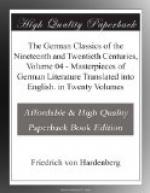Kleist evidently studied the models of classical art with care. His unerring sense of form, his artistic restraint in a day when caprice was the ruling fashion, and the conciseness of his expression, are doubtless due to classical influence. But, at the same time, he was an innovator, one of the first forerunners of modern realism. He describes and characterizes with careful, often microscopic detail; his psychological analysis is remarkably exact and incisive; and he fearlessly uses the ugly or the trivial when either better serves his purpose.
In all the varied volume of Kleist’s works, there is very little that is mediocre or negligible. The Schroffenstein Family, to be sure, is prentice work, but it can bear comparison with the first plays of the greatest dramatists. The fragment of Robert Guiscard is masterly in its rapid cumulative exposition, representing the hero, idolized by his troops, as stricken with the plague when the crowning glory of his military career seems to be within his grasp; while the discord between Guiscard’s son and nephew presages an irrepressible family conflict. The style, as Wieland felt when he listened with rapture to the author’s recital, is a blend of classical and Elizabethan art. The opening chorus of the people, the formal balanced speeches, the analytical action, beginning on the verge of the catastrophe, are traits borrowed from Greek tragedy. On the other hand, there is much realistic characterization and a Shakespearian variety and freedom of tone. The Broken Jug, too, is analytical in its conduct. Almost from the first it is evident that Adam, the village judge, is himself the culprit in the case at trial in his court, and the comic efforts of the arch-rascal to squirm out of the inevitable discovery only serve to make his guilt the surer. In this comedy the blank verse adapts itself to all the turns of familiar humorous dialogue, and the effect of the Dutch genre-paintings of Teniers or Jan Steen is admirably reproduced in dramatic form. The slowly moving action, constantly reverting to past incidents, makes a successful performance difficult; the fate of this work on the stage has depended upon finding an actor capable of bringing out all the possibilities in the part of Adam, who is a masterpiece of comic self-characterization.
Penthesilea is a work apart. Passionate, headlong, almost savage, is the character of the queen of the Amazons, yet wonderfully sweet in its gentler moods and glorified with the golden glow of high poetry. Nothing could be further removed from the pseudo-classical manner of the eighteenth century than this modern and individual interpretation of the old mythical story of Penthesilea and Achilles, between whom love breaks forth in the midst of mortal combat. The clash of passions creates scenes in this drama that transcend the humanly and dramatically permissible. Yet there is a wealth of imaginative beauty and emotional melody in this tragedy beyond anything in Kleist’s other works. It was written with his heart’s blood; in it he uttered all the yearning and frenzy of his first passion for the unattainable and ruined masterpiece Guiscard.




